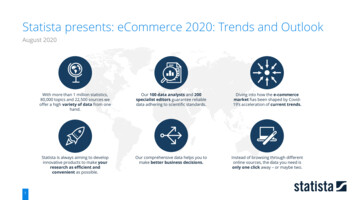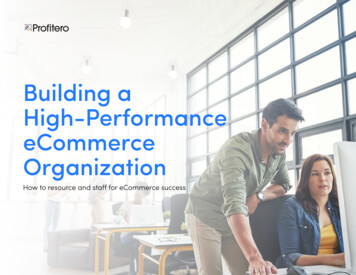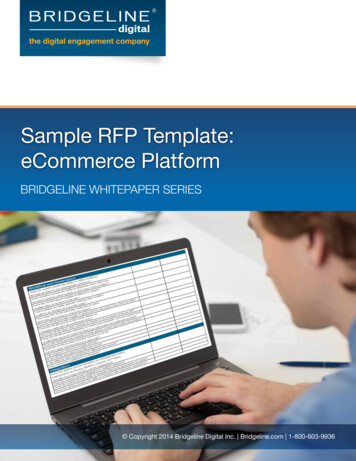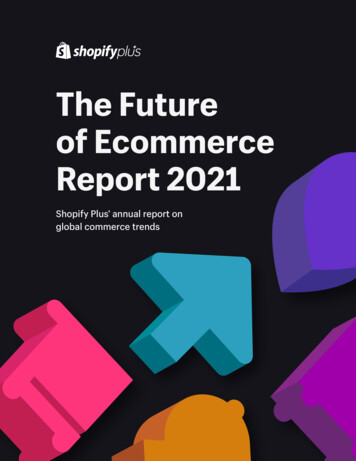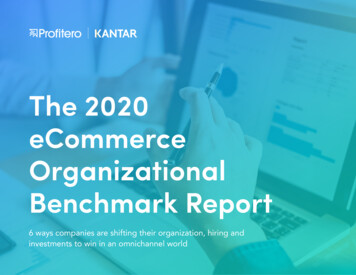
Transcription
The 2020eCommerceOrganizationalBenchmark Report6 ways companies are shifting their organization, hiring andinvestments to win in an omnichannel world
IntroductionThe past decade has seen radical shifts in consumerbehavior driven by digital technologies that havetransformed every facet of our lives, from how weare entertained (Netflix) to how we get our news(Facebook, Twitter) and how we connect with loved ones(FaceTime).Perhaps no consumer behavior has seen as much transformation,however, as the most mundane of all — shopping. As we enter 2020,online shopping continues to be central to shoppers’ routines, a trendthat is only set to be magnified by the current COVID-19 pandemiccrisis. 49% of US shoppers 18 prefer to shop for and buy productsonline, and 77% of all shoppers say online shopping is a consistentor occasional part of their shopping routines (ShopperScape , OnlineShopping Survey, 2020).In 2019, retailers upped their game in trying to capture this digitalspend. Amazon made major investments in grocery delivery andgrocery stores. Walmart and Target ratcheted up their online-to-storefulfillment services, mirroring a model Europe has had in place forResearch methodologyyears. Amazon Prime membership reached 150 million subscribers,driven by global expansion.Profitero and Kantar conducted an online survey of brand manufacturers to determineIt’s with these developments as a backdrop that Profitero andtheir top organizational priorities, challenges, hiring plans, and more as they relate toKantar joined together to conduct our fourth annual eCommerceeCommerce. The survey was fielded from September to December 2019. Responsesorganizational benchmark survey.were collected from a total of 196 respondents.While the majority of respondents were from North America, we also had participationfrom Europe, Asia, Latin America, and Africa. Respondents were from companies ofall sizes and all industries, including apparel/footwear, baby, beauty and cosmetics,beverage/alcohol, DIY/tools, electronics, grocery/food, home goods, office supplies,pet supplies, pharmacy/health & wellness, sporting goods, and toys.T H E 2 0 2 0 E C O M M E R C E O R G A N I Z AT I O N A L B E N C H M A R K R E P O R T2
Executive summarySix trends emerged from this year’s study, which includedfeedback from nearly 200 brand professionals:135In the face of increasing complexity and competition,Half of respondents (50%) rank handling challengingOrganizations have invested more in product contentfew organizations feel like they are in a positionpricing and profitability scenarios as their topthan any other area of eCommerce, but still struggleto win in eCommerce. Just 17% of brand leaderseCommerce challenge. However, most organizationsto achieve quality over quantity. Our survey showedsurveyed believe their companies are ahead of theare trying to force fit offline strategies into the onlinethat 60% of companies have only basic content and/curve when it comes to organizing for eCommerce.world, which is only making channel conflict andThe vast majority (71%) report they are merelyor basic enhanced for top SKUs; only 15% areprofitability issues worse. One-quarter of respondentsoptimizing content to lift sales.keeping pace or catching up.(25%) report their organizations lack a dedicatedeCommerce assortment strategy, while 38% report2they are simply adapting their offline assortment for6eCommerce. Nearly one-third (32%) report that theyThe true promise of using data and analytics toDespite being vocally supportive of eCommerce,have yet to develop an eCommerce-specific pricingdrive sales growth remains elusive; most organizationsC-level executives are not doing enough to set astrategy.are simply using data to “report the weather.” 61%clear strategy for their organizations, leading to“channel silos” and confusion about job roles andresponsibilities. Our survey revealed that 40% sayof respondents surveyed are accessing sales and4share data only for their retailer websites and are notinvesting in digital shelf or shopper panel data totheir organizations lack concrete goals or measurableSupply chains are not getting enough investmentobjectives for eCommerce. Only 11% of respondentsunderstand how to optimize opportunities. Only 8%to keep pace with the complexity of meetingare applying predictive analytics in their eCommercesay that each functional team in their organization hasomnichannel demand, creating real risk that canbusiness.specific eCommerce goals built into strategic growthalready be observed with the current pandemic.plans and KPIs.For example, 41% of respondents don’t have aspecialized team or set of processes for managingtheir eCommerce supply chain, relying on those usedto manage brick-and-mortar.T H E 2 0 2 0 E C O M M E R C E O R G A N I Z AT I O N A L B E N C H M A R K R E P O R T3
Key findings
1. eCommerce has become more complex, andorganizations are feeling the burdenJust 17% of brand leaders we surveyed believe theircompanies are ahead of the curve when it comes toorganizing for eCommerce. The vast majority (71%)Q: What’s your maturity level in terms of organizing around eCommerce?Source: Kantar/Profitero 2019 eCommerce Benchmarking surveyreport they are merely keeping pace or catching up.This feeling of treading water is not surprising giventhe increased complexity of eCommerce. There11%Just starting to operationalizeand participate in eCommerceare more online retailers and more challenges aseCommerce organizations shift from siloed efforts tointegrating across the organization. The proliferationof eCommerce marketplaces and the challenges ofdealing with third-party sellers also have contributedStrong focus on eCommercebut still catching up tocompetition36%to the complexity. Retailers are expanding theirrevenue streams, including service areas likesponsored paid search and media, to continuegrowing. Digital pure players continue to emerge,putting pressure on incumbent brands. Essentially,Strong focus on eCommerceand keeping pace with the35%competitionthe bar has never been higher for expertise on themanufacturer side.Ahead of the curve andleading in eCommerce vs.the competitionDon’t know / not applicable17%1%T H E 2 0 2 0 E C O M M E R C E O R G A N I Z AT I O N A L B E N C H M A R K R E P O R T5
2. Leadership must do more to set a clear eCommercestrategy and clarify ways of workingTo understand why organizations are feeling behindin eCommerce, look no further than the leaders. Oursurvey shows that many organizations lack a truestrategy for integrating eCommerce into the overallorganizational structure and job responsibilities ofeveryone in the company. While 40% of respondents report that leadershiphas made eCommerce a stated priority for theirQ: In the area of eCommerce strategy & leadership, how would you rate yourorganization’s capabilities/approach?Source: Kantar/Profitero 2019 eCommerce Benchmarking surveyN OV I C E40%Leadership has articulatedthat eCommerce is a strategicpriorityorganization, they acknowledge that no concrete goals or measurable objectives have been setA DVA N C E Dbeyond that.Measureable eCommercegoals established and activelytrackedJust 11% of brand respondents report that eachfunctional team within their organization hasspecific eCommerce goals built into their strategicEXPERTgrowth plans and KPIs.eComm goals aligned withcore customer strategies anda focal point for key customerinteractionsSince eCommerce touches every aspect of theorganization, cross-functional buy-in is essential;however, many eCommerce teams are hitting a wall ingaining the support they need from cross-functionalpartners. As one survey respondent put it, “Ourbiggest challenge is gaining buy-in from stakeholdersthat don’t see direct impact from eCommerce; i.e.,24%19%LEADEReComm fully embedded inbroader company growthstrategies and across allfunctional plans11%product marketers responsible for updating content.”Don’t know / not applicable6%T H E 2 0 2 0 E C O M M E R C E O R G A N I Z AT I O N A L B E N C H M A R K R E P O R T6
3. The challenges of managing profitability andsupply weigh heavily on brands50% of respondents rank handling challengingpricing and profitability scenarios as their eCommercetop challenge.Q: What are the top challenges that you have around organizing for eCommerce?(Rank top 3)Source: Kantar/Profitero 2019 eCommerce Benchmarking surveyAfter pricing and profitability, 40% of respondentssay that adapting the existing supply chain to fiteCommerce demands is their next top challenge.50%Handling challenging pricingand profitability scenariosLess of a challenge for brands is the ability to getapproval for eCommerce budget or the ability tohire, suggesting that most organizations are past theearly stages of trying to make a business case forAdopting existing supplychain to fit demands ofeCommerce40%eCommerce and are now dealing with the much moremature issue of competing in the channel.Finding more effective waysto partner with retailers todrive sales35%34%Measuring the return oninvestment in eCommerceEstablishing a clear andwell-understood eCommercestrategy32%28%Attribution for onlineinfluence on offline salesSecuring incremental,dedicated headcountGetting budget approval21%16%T H E 2 0 2 0 E C O M M E R C E O R G A N I Z AT I O N A L B E N C H M A R K R E P O R T7
3. The challenges of managing profitability andsupply weigh heavily on brands (continued)The survey also reveals that most organizations aretrying to force fit offline strategies into the onlineworld, which is only making channel conflict andprofitability issues worse. One-quarter of respondents(25%) report their organizations lack a dedicatedeCommerce assortment strategy, while 38% reportthey are simply adapting their offline assortment foreCommerce.Q: In the area of eCommerce assortment & innovation, how would you rate yourorganization’s capabilities/approach?Source: Kantar/Profitero 2019 eCommerce Benchmarking surveyN OV I C E25%Do not have a dedicatedeCommerce assortmentstrategyA DVA N C E DAdapt our assortment tomeet the requirements ortrends for eCommerce38%EXPERTDedicated product strategyand innovation processfocused on eComm21%LEADERDedicated product strategyand innovation processfocused on distinct eCommretailer and fulfillmentmodelsDon’t know / not applicable13%6%T H E 2 0 2 0 E C O M M E R C E O R G A N I Z AT I O N A L B E N C H M A R K R E P O R T8
3. The challenges of managing profitability andsupply weigh heavily on brands (continued)Nearly one-third (32%) report that they have yet todevelop an eCommerce-specific pricing strategy,while only 15% of brands have implemented legal(minimum advertised price, or MAP) policies toQ: In the area of eCommerce price & promotion management, how would you rateyour organization’s capabilities/approach?Source: Kantar/Profitero 2019 eCommerce Benchmarking surveyprotect themselves from extreme price discountingby online retailers and marketplace sellers.N OV I C EAs retailers continue to use algorithmic-basedNo eCommerce-focusedpricing strategymethods to match prices, the lack of eCommerce-32%specific price and promotion strategies will exposecompanies to lower profitability.A DVA N C E D“We lack policy enforcement from sites like AmazoneCommerce integrated intocross-channel pricing strategyand eBay, allowing undercutting of prices, oldinventory, and misrepresentation of our brand.”— Survey respondent“Operations product configuration is our next bigchallenge. Creating items that leverage eCommercecost structure to be optimized for profitability.”18%EXPERTHave integrated digitalpromotions into crosschannel pricing and TPM/TOPprocesses8%— Survey respondentEXPERTHave a MAP/eMAP policy15%LEADERHave dedicated focust atthe channel level for brandprotection, MAP enforcementor promotional effectivenessDon’t know / not applicable17%10%T H E 2 0 2 0 E C O M M E R C E O R G A N I Z AT I O N A L B E N C H M A R K R E P O R T9
4. Supply chain is underfunded relative to thecomplexities of managing omnichannel demandThe current pandemic has revealed just how sensitivesupply chains (both online and brick-and-mortar) canbe to volatility in consumer demand.Q: In the area of eCommerce supply chain & fulfillment, how would you rate yourorganization’s capabilities/approach?Source: Kantar/Profitero 2019 eCommerce Benchmarking surveyOur survey found that, on the whole, mostorganizations haven’t invested enough to specializeN OV I C Eand upgrade their supply chains to meet the complexeCommerce supply chainis managed by a fulfillmentgeneralistneeds of eCommerce, where inventory must be bothshipped and ready to meet demand from consumers41%ordering online and picking up in store.For example, 41% of respondents don’t have aspecialized team or set of processes for managingtheir eCommerce supply chain — a concerning gapconsidering the influence supply chain has on bothtop-line sales (by preventing out-of-stocks) andbottom-line profitability (driving efficiency).A DVA N C E DeCommerce supply chain hasdedicated management andprcoesses21%EXPERTeComm supply chain hasdedicated mgmt. andis highly responsive tocustomers, with activeanticipation of out-of-stocks15%LEADEReComm supply chain hasdedicated mgmt. and isexploring new, innovativelogistics models (e.g., dropship, back haul)Don’t know / not applicable12%11%T H E 2 0 2 0 E C O M M E R C E O R G A N I Z AT I O N A L B E N C H M A R K R E P O R T10
5. Organizations are struggling to do little more thantackle the basics when it comes to contentMore than half of survey respondents (51%) havedigital asset management/product informationmanagement (DAM/PIM) solutions for managingcontent, making it one of the most widely used toolsQ: In the area of eCommerce content management, how would you rate yourorganization’s capabilities/approach?Source: Kantar/Profitero 2019 eCommerce Benchmarking surveythat organizations invest in, trailing only retailer salesN OV I C Eand share measurement systems. (See next page).Basic content in place acrossmost/all SKUs on retailersitesDespite these tools to make content management22%more efficient, most brands are doing little tooptimize their content to ensure it is outpacing theA DVA N C E Dcompetition. Only 37% of survey respondents areBasic SKUs in place andaligned to industry/retailerbest practices and enhancedcontent untilized for top SKUsactively benchmarking and optimizing content forgreater sales impact; while only 15% are optimizingcontent to lift sales.38%EXPERTAll of the above plus activeretailer site auditing to ensurecompliance benchmark vs.competition22%LEADERAll of the above plusanalytical processes toidentify content optimizationsthat drive brands sales liftDon’t know / not applicable15%3%T H E 2 0 2 0 E C O M M E R C E O R G A N I Z AT I O N A L B E N C H M A R K R E P O R T11
5. Organizations are struggling to do little more thantackle the basics when it comes to content (continued)Despite the rising amount of budget that brandsare investing in sponsored advertising (especiallyon Amazon), only 26% of organizations haveimplemented programmatic search/mediaoptimization tools, showing that most organizationsstill believe “content” is king.There is still a large gap (12 ppts) betweenorganizations that have DAM/PIM systems anddigital-shelf/e-store auditing solutions, furtherreinforcing the point that the goal with content isQ: Does your organization have any of the below types of systems in place?Source: Kantar/Profitero 2019 eCommerce Benchmarking survey65%Account specific sales/sharemeasurementContent/asset mgmt.(PIM/DAM)51%49%Pricing/MAP monitoringjust to get it out there, not so much to know if it’sgood.47%Ratings/review syndicationDigital shelf/e-audit39%Total market eCommercesales & share39%Where to buy or distributedcommerce37%Content syndication36%26%Programmatic search/mediaoptimization19%Shopper behavior panelNone9%T H E 2 0 2 0 E C O M M E R C E O R G A N I Z AT I O N A L B E N C H M A R K R E P O R T12
6. The power of data and analytics is not beingfully leveraged to grow salesSimilar to content, most organizations are strugglingto get past the basics when it comes to theireCommerce data and analytics strategy. Mostly, datais being used to “report the weather” instead ofQ: In the area of eCommerce data & analytics, how would you rate your organization’scapabilities/approach?Source: Kantar/Profitero 2019 eCommerce Benchmarking surveyfinding opportunities for optimization and growth. 61% of respondents surveyed are accessingsales and share data only for their retailerN OV I C E16%Ad hoc eCommerce salesperformance trackingwebsites and are not investing in digital-shelfor shopper panel data to understand how to optimize opportunities.N OV I C EOnly 8% are applying advanced analytics toOngoing eCommerce salesperformance trackingtheir eCommerce business, creating modelsto understand the impact specific levers arehaving on sales and predict where investmentis needed. Multiple respondents in our surveycited the need for better forecasting methods forAmazon, given the unpredictability and volatilityof demand. Getting a unified view of performance thatcaptures the many fragmented channelsof eCommerce remains elusive. As onesurvey respondent put it: “Having a reliablemeasurement approach for eCommerce,including direct ship, click-and-collect, and thirdparty delivery, has been really elusive. It is hardto manage what you can’t measure accurately.”45%A DVA N C E DOngoing sales tracking plusanalysis of non-sales datasources (e.g., digital shelf,shopper panel)21%EXPERTOngoing sales tracking andintegration of disparate datasets for advanced analytics3%LEADERAll of the above plus advancedanalytics (e.g., predictiveforecasting, causal analytics,regression modeling, etc.)Don’t know / not applicable8%7%T H E 2 0 2 0 E C O M M E R C E O R G A N I Z AT I O N A L B E N C H M A R K R E P O R T13
6. The power of data and analytics is not beingfully leveraged to grow sales (continued)Most organizations are not sitting idly by, however.They are looking to do more with data, as evidencedby hiring plans for the coming year. 17% of respondents say their organizationis planning to hire more employees for dataQ: For which of the following roles does your company have dedicatedeCommerce headcount?Source: Kantar/Profitero 2019 eCommerce Benchmarking surveyPlannedIn placeanalytics/insights, the #1 role planned for in2020. 16% are looking to hire for capabilitymanagement in 2020. This role, which can varyby organization, is commonly someone who isresponsible for bringing multiple eCommercetools and data sources together and whooversees the overall building of a cohesive,integrated tech stack for eCommerce needs.NoneData analytics/insights17%51%32%Capability management16%Search optimization, mgmt.13%Digital marketing,media r marketing12%eCommerce category mgmt.12%IT11%Brand management10%56%34%Direct to consumer10%55%35%Supply chain9%eCommerce GM/VP/Director6%Account mgmt./sales3%31%53%48%39%62%72%36%15%53%51%45%T H E 2 0 2 0 E C O M M E R C E O R G A N I Z AT I O N A L B E N C H M A R K R E P O R T25%37%43%55%36%67%83%27%15%14
Key implications & takeaways1Create clear eCommerce KPIs and goals foreveryone in the company. Removing silos across23Start structuring now for omnichannel. SeveralRaise your organization’s eCommerce IQ. To buildleading omnichannel retailers are expected to surpasstheir eCommerce capabilities, organizations willbusiness functions is critical to advance to the nextAmazon’s growth by 2025 according to Kantar retailneed to invest in eCommerce training. This will helplevel of eCommerce. Organizations that will get, andsales forecasts. Companies must exploit this and gainmanufacturers solve two pain points: hiring peopleremain, ahead are those that employ eCommerceshare by building eCommerce capability (people,from within into eCommerce roles and reta
strategy for integrating eCommerce into the overall organizational structure and job responsibilities of everyone in the company. While 40% of respondents report that leadership has made eCommerce a stated priority for their organization, they acknowledge that no concrete goals or measurable objectives have been set beyond that.
